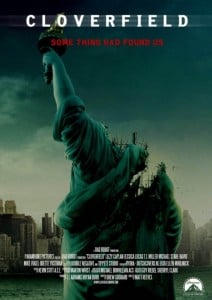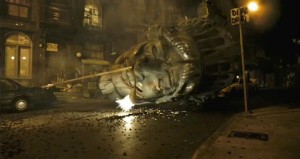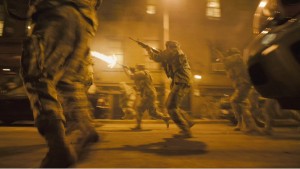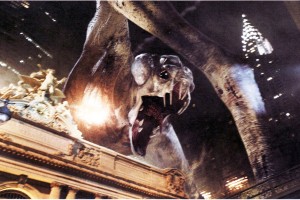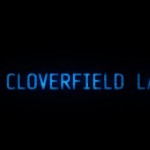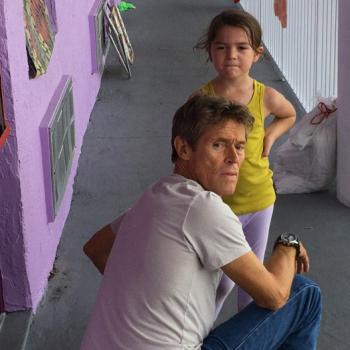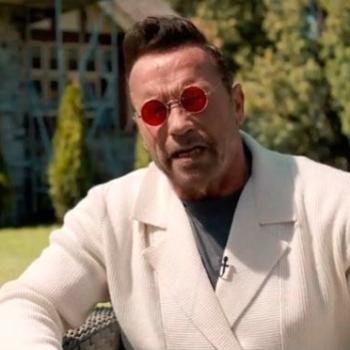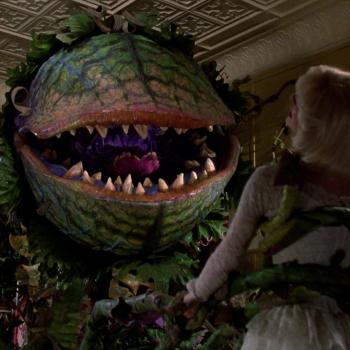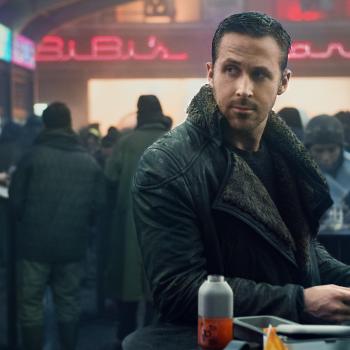Eight years later, “Cloverfield’s” biggest legacy might be its trailer.
That’s an odd thing to say for a movie that brought in a healthy $80 million at the box office and was one of the first hits for JJ Abrams’ Bad Robot production company, let alone that one that has a pseudo-sequel coming out this week. But admit it, what “Cloverfield” is best known for is its trailer.
And it is a great trailer. It shows just enough to let us know some crazy things are going on, but it never tells us exactly what is happening. There are explosions, panic in the streets and that great final shot of the Statue of Liberty’s head rolling down the road. Is it a war? Alien invasion? The trailer never says. And for many who first saw that trailer attached to “Transformers,” it was better than the movie that followed (not that that takes much). It’s JJ Abrams’ “mystery box” done to perfection.
The thing that made it great, though, is that it was the rare trailer that announced a movie that no one knew existed. In an age where film sites regularly post every bit of news from every in-production blockbuster, that’s nearly unheard of. But no one knew that newbie director Matt Reeves was filming a monster movie for producer JJ Abrams. The movie didn’t even have a name at that point. Suddenly, here was this big disaster movie, and no on knew what it was about. There was speculation that it was a tie-in to “Lost,” a World War III movie and, most amusingly, a live-action “Voltron” adaptation (based on the mishearing of “It’s alive!” as “It’s a lion!”). There were online clues that, admittedly, had little to do with the actual movie, and even the final title, “Cloverfield,” was a random name that just gained traction. It was one of the great movie marketing campaigns, and kudos to Abrams and company for pulling something similar off with the surprise release of “10 Cloverfield Lane.”
But nearly a decade later, the reputation of the film itself is muted, even as it has an impressive 77% on Rotten Tomatoes. Sure, the people involved has gone onto some big things: Abrams, of course, revived “Star Wars,” Reeves has turned into one of the great genre directors with “Let Me In” and “Dawn of the Planet of the Apes,” and co-star TJ Miller has gotten big laughs in “Silicon Valley,” “Big Hero 6” and “Deadpool.” But the movie itself is looked at with a shrug, just another in a sea of found footage movies and monster tales, a victim of the subgenres it helped revive.
Which is a shame, because “Cloverfield” is actually a solid addition to the monster movie canon, and it’s one of the few great found footage movies. Watching it again, after a flood of “Paranormal Activity” sequels and their ilk have rendered found footage unpalatable, I remain impressed.
The film is a monster movie on par with “Godzilla,” but with a scope more akin to “Signs” or “War of the World.” Its focus is not on the worldwide response or the fight against the beast. Rather, it’s about regular people caught in the chaos, and their attempts to stay alive. It opens at a going-away party for Rob (Michael Stahl-David), who’s taken a job in Japan. His best friend Hud (Miller) is capturing goodbye testimonies from friends when the New York loft they’re in is shaken by an explosion. Heading out to see the damage, the party-goers discover that a giant monster has come up from the sea and is wreaking havoc. While most of the people evacuate, Rob and a few of his friends trek across Manhattan to rescue Beth (Odette Annabelle), who has been trapped after storming out of the party in a huff. The entire story is told from Hud’s point of view as he keeps the camera rolling.
The main complaints I hear about the movie stem from that last part. And granted, some people just don’t like the found footage conceit. I’ll admit it’s not a subgenre that I’m overly fond of. In the right hands, it can be very effective, and I’m a fan of “The Blair Witch Project” and the first “Paranormal Activity.” But it’s an approach that is probably best used sparingly; most of the time, directors turn to found footage not because they’ve found a new approach or feel that the aesthetics complement the story’s themes, but because it’s cheap and requires little to no skill to pull off at a basic level. For the most part, the complaints leveled against “Cloverfield” are the same ones I hear leveled against all found footage movies: “it makes me sick” and “why do they keep filming.”
There’s really not much I can say in defense of the first argument. For some people, the blurry, shaky motion of handheld cameras is just too much for them. I understand that, and it’s a complaint I’ve used against many action films that use “shaky cams” to hide their lack of choreography. But if a movie’s conceit is that it’s being filmed with a camcorder in a situation of utter chaos, some blurriness (and, perhaps, nausea) is the price you pay for the story.
As for the second complaint, it’s valid but explained. There’s a sequence where the group is running across the Brooklyn Bridge and someone asks Hud why he’s still filming. “People will want to know what happened,” he replies. It might not be a perfect response, but I think it’s fine. After all, how many times does amateur video surface after a riot or disaster? How many hours of civilian video existed after the 9/11 attacks, showing the terror from the streets of New York as confusion took hold of the city? Even when people were running from collapsing buildings, many still kept their video cameras on.
That’s an important piece of context, because “Cloverfield” is a monster movie filtered through the lens of 9/11. Perhaps more explicitly than even Spielberg’s “War of the Worlds,” it uses imagery from that day — whether it’s a dust cloud billowing the street as a building collapses or the chilling image of one skyscraper collapsed onto another — to put us into the middle of the event. It might be exploitative, but it works. September 11 was a day when Americans were reminded that war and terror could be brought to them, when we found ourselves in the middle of what many compared to a Michael Bay movie. For those not in New York, we saw images of that day broadcast in real-time on TV. For many who were down there, they witnessed it through their camera’s lens, whether as a way of documenting it or to put distance between themselves and real-life horror. It was only a matter of time before Hollywood dealt with fictional disaster in the same way.
But the found footage trope also allows Reeves to create a monster movie of surprising scope on a tiny budget ($25 million). The movie feels big because we see everything from ground level, getting just a glimpse of an army firefight or of the monster slamming through a building. Reeves stages several innovative sequences, such as a perilous climb across a damaged building or a disastrous helicopter flight. And he uses the found footage technique to draw horror out of several of those sequences, using the night vision to stage a surprise attack from parasites in the subway or showing us a character’s fate in quarantine while leaving much to our imagination. Gareth Edwards may have perfected the idea of monster movie scale with the most recent “Godzilla,” but “Cloverfield” captures it with more immediacy and visceral terror. It also moves, charging through in under two hours, making it a tense, effective exercise.
And it still finds a way to deliver moments of poignancy. Throughout the film, the camera card hiccups, revealing footage of Rob and Beth in happier times. Before the story begins, we get a glimpse of them just after they first slept together, a momentous moment in their lifelong friendship. We get glimpses of that happy day breaking through during the film, most powerfully when the harrowing climax cuts out to show us the end of a previous good day. It’s not the most poetic character development, but it gives the film a bittersweet undercurrent. And while the glimpses of Rob and his friends at the party reveal him to be a bit of a shallow, cliche dude character, the film acknowledges that. “You’re a douche,” his brother tells him at one point, and while Rob’s journey to show Beth how he feels might be extremely familiar, it gives the film some emotional heft.
Granted, most of the other characters are simply monster food. Rob’s brother and his girlfriend are largely non-entities, and Beth only exists as a damsel in distress, up through the film’s climax. But Miller and Lizzy Caplan, as Hud’s love interest and shaken partygoer Marlena, have a nice comic rapport to their scenes that gives the film more personality and heart than the found footage subgenre usually allows. “Cloverfield’s” characters aren’t particularly memorable, but they’re serviceable, and that’s enough to give the movie some genuine stakes.
“Cloverfield” holds up. Maybe not as a sterling example of cinema, but it’s also more than just a post-9/11 capsule piece. It takes the monster movie seriously and makes the previously cheesy genre legitimately scary and tense. It’s one of the rare found footage movies that uses the technique wisely, and its a great example of how JJ Abrams’ “mystery box” theory can work as a fantastic marketing technique. Sorry if it makes you sick, but it’s a movie I quite enjoy.

